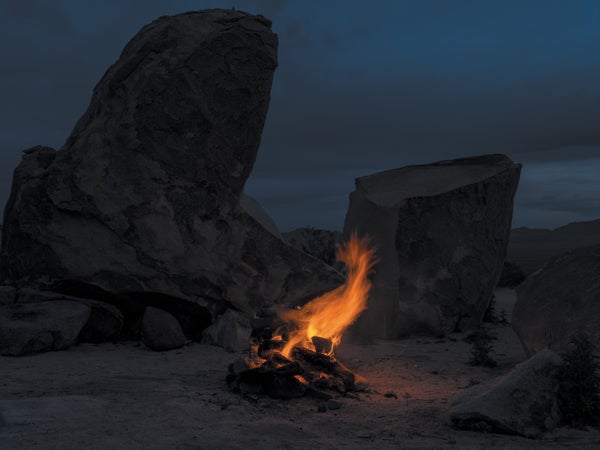When I was 18, a few days after graduating from high school, I found myself on a forest fire crew at Grand Canyon National Park in Arizona. I returned for 15 seasons, 12 as crew boss, and I became a pyromantic. For those years I lived one life at a university and another on the canyon’s North Rim. On a fire crew, you quickly learn how fires can shape a season and how seasons can shape a life. I found a way to reconcile my two lives and became a scholar on fire.
我 18 岁那年,高中毕业没几天,就加入了亚利桑那州大峡谷国家公园的森林防火队。我在那里工作了 15 个季度,其中 12 个季度担任组长,成为了一名火魔。这些年来,我在大学过着一种生活,在峡谷北缘过着另一种生活。在救火队里,你很快就会了解到大火是如何塑造一个季节的,而季节又是如何塑造人生的。我找到了调和两种生活的方法,成为了一名消防学者。
My first fire, in June 1967, was a lightning-blasted snag on Powell Plateau, an isolated mesa in the Grand Canyon. Fifty-six years later I’ve written works about fire on every continent, among them primary histories for the U.S., Canada, Mexico, Australia and Europe, including Russia. My focus has been to chronicle the relationship between fire and humans, an alliance that has remade, and unhinged, the planet. Here’s how that happened—and how I think we can restore balance.
我的第一次火灾发生在 1967 年 6 月,是在鲍威尔高原(大峡谷中一个与世隔绝的山丘)上被闪电击中。56 年后,我写下了关于各大洲火灾的作品,其中包括美国、加拿大、墨西哥、澳大利亚和欧洲(包括俄罗斯)的主要历史。我一直专注于记录火与人类之间的关系,这一联盟重塑了地球,也让地球失去了活力。以下是这一切是如何发生的--以及我认为我们如何才能恢复平衡。
Earth is a fire planet, the only one we know of. Earth has fire because it has life. Life created the oxygen fire needs; life created and arranges the fuel it requires. Even the chemistry of fire is a biochemistry: fire takes apart what photosynthesis puts together. As long as terrestrial life has existed, so has fire.
地球是一颗火星,是我们所知的唯一一颗火星。地球有火是因为它有生命。生命创造了火所需的氧气;生命创造并安排了火所需的燃料。甚至火的化学反应也是一种生物化学反应:火将光合作用合成的东西拆开。只要地球上有生命存在,火也就存在。
Fire takes on some properties of the living world it depends on. In ways, it resembles a virus—something not truly alive but that requires the living world to propagate. And like a virus, fire propagates by contagion.
火具有它所依赖的生命世界的某些特性。在某些方面,它类似于病毒--一种并非真正有生命,但需要生命世界来传播的东西。和病毒一样,火也是通过传染来传播的。
The one requirement of fire that life did not furnish was ignition. That changed with the appearance of a genus, now a single species, that could start fire at will: ours. Humans became unique fire creatures. We used fire to remake ourselves, and then we and fire remade Earth.
生命对火的唯一要求就是点火。随着一种可以随意点火的属种(现在是单一物种)的出现,这种情况发生了改变:那就是我们人类。人类成为了独一无二的火生物。我们用火来改造自己,然后我们和火一起改造地球。
We developed more compact guts and big heads because we learned to cook food. We went to the top of the food web because we learned to cook landscapes for hunting, foraging, farming and herding. And we have become a geological force because we’ve begun to cook the planet. Becoming the keystone species for fire made us the keystone species for Earth. Not only can we start (and, within limits, stop) fire, but fire serves as a fulcrum for our desires, good and bad. The fire stick became an Archimedean lever with which we move the world.
因为我们学会了烹饪食物,所以我们有了更紧凑的内脏和更大的脑袋。我们登上食物网的顶端,是因为我们学会了烹饪狩猎、觅食、耕作和放牧的景观。我们已经成为一股地质力量,因为我们开始 "烹饪 "地球。成为火的关键物种使我们成为地球的关键物种。我们不仅可以生火(在一定范围内也可以灭火),而且火还是我们欲望的支点,无论好坏。火棒成了我们撬动世界的阿基米德杠杆。
Our relationship with fire grew as we domesticated it. Fire had to be birthed, fed, trained, sheltered, tended—we even have to clean up after it. For many intellectuals, from Roman architect Vitruvius to 20th-century French anthropologist Claude Lévi-Strauss, fire control separates the civilized from the barbaric. Fire is also a core technology and a foundation for chemistry. With fire we turn mud into brick and pottery, limestone into cement, sand into glass, ore into metal; fire always seems to exist somewhere in the life cycle of made things and in built environments. And working fires have illuminated, warmed and powered almost all human activities from religious sacrifices to the forging of weapons.
随着我们对火的驯化,我们与火的关系也在不断发展。火必须被孕育、喂养、训练、庇护、照料--我们甚至必须为它打扫卫生。对许多知识分子来说,从古罗马建筑师维特鲁威到 20 世纪法国人类学家克劳德-列维-斯特劳斯,火的控制将文明与野蛮区分开来。火也是化学的核心技术和基础。有了火,我们才能把泥巴变成砖块和陶器,把石灰石变成水泥,把沙子变成玻璃,把矿石变成金属;火似乎总是存在于人造物品和建筑环境的生命周期中。从宗教祭祀到锻造武器,人类几乎所有的活动都离不开火的照明、取暖和驱动。
In a sense, early humans and fire made a pact for mutual assistance: each would expand the realm of the other. People would carry fire to places and times in which it could not have existed otherwise. In return, fire empowered humans to go everywhere and do far more than their primate ancestors could ever have imagined. If humans colonize other planets, they will leave Earth on plumes of flame.
从某种意义上说,早期人类与火结下了互助之约:各自拓展对方的领域。人们将带着火种去到不可能存在火种的地方和时代。作为回报,火使人类有能力去任何地方,所做的事情远远超出了他们灵长类祖先的想象。如果人类殖民其他星球,他们将带着火焰离开地球。
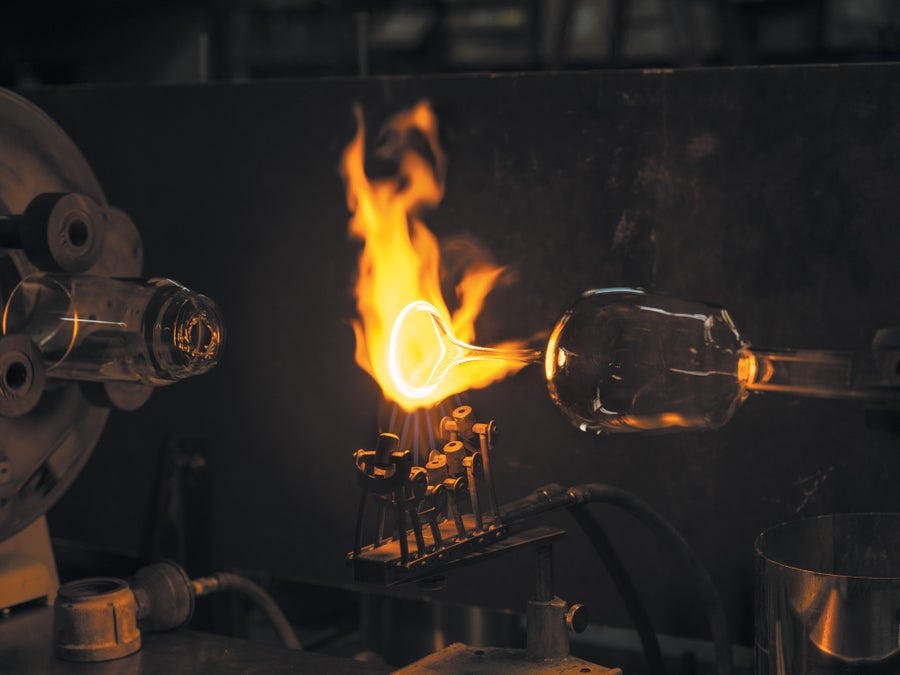
Kevin Cooley 凯文-库利
Yet limits existed. People and the flames they sparked were constrained by terrain, vegetative fuels and climate. Anthropogenic fire could alter some of those conditions but not at a planetary scale. That began to change about 12,000 years ago, at the end of the last glacial period. A fire-wielding creature met an increasingly fire-receptive world. With tugs and yanks and positive feedback, a planetary makeover began that is rampant today. The Holocene epoch that followed the last glaciation is an Anthropocene or, given the catalytic role of fire, a Pyrocene.
然而,限制是存在的。人类及其引发的火焰受到地形、植被燃料和气候的限制。人类活动引起的火灾可以改变其中的一些条件,但不能改变整个地球的气候。大约在 1.2 万年前,即上一个冰川期结束时,这种情况开始发生变化。一个挥舞着火把的生物遇到了一个对火越来越敏感的世界。在牵引、拉扯和正反馈作用下,一场地球大改造开始了,如今仍在肆虐。上一次冰川期之后的全新世是人类世,或者说,考虑到火的催化作用,是火新世。
The Pyrocene, a concept and term I created several years ago, is an interpretation of Earth’s fire history as an amalgam of three fires. I’ll use the U.S. to illustrate this idea.
二迭纪是我几年前创造的一个概念和术语,它将地球的火灾历史解释为三种火灾的混合体。我将用美国来说明这一概念。
“First fire” is nature’s fire. Geologists have found fossil charcoal that is more than 420 million years old. Lightning was overwhelmingly the ignition source. Yet by the time the 1880 U.S. census mapped forest fires across the country, there was little overlap between lightning-kindled fires and the many burns on the ground. Humans were responsible for the vast majority of the burning. Indigenous peoples used fire for hunting, foraging, fishing and general land maintenance; fire could render landscapes more habitable. Newcomers, too, had a fire heritage that they hauled across the Atlantic, one embedded in agriculture and pastoralism. With contact between peoples, the fires of the two groups met and merged. Native practices better adapted to local sites were often adopted or modified to accommodate livestock and new crops. But even though people working the land never doubted the value of fire in sustaining their livelihoods, elites in the New World often echoed those of the Old World who distrusted and feared fire as messy, dangerous and wasteful, a stigma of primitivism.
"第一把火 "是大自然的火。地质学家发现了距今超过 4.2 亿年的木炭化石。闪电是绝大多数火灾的火源。然而,在 1880 年美国人口普查绘制全国森林火灾地图时,闪电引发的火灾与地面上的许多火灾几乎没有重叠。绝大多数火灾都是人类造成的。原住民利用火来狩猎、觅食、捕鱼和维护土地;火可以使土地更适合居住。新移民也有火的传统,他们带着火种穿越大西洋,这种传统蕴含在农业和畜牧业中。随着民族间的接触,两个群体的火种相遇并融合。为了适应牲畜和新作物的生长,当地人通常会采用或修改更适合当地的做法。尽管在土地上劳作的人们从未怀疑过火在维持生计方面的价值,但新世界的精英们往往与旧世界的精英们一样,不信任火,害怕火,认为火是混乱、危险和浪费的,是原始主义的烙印。
These human-handled fires constitute a “second fire,” which is first fire domesticated, or at least tamed, and used to create a landscape more amenable to human habitation. Compare the 1880 geography of fires to that of human settlement, and you’ll find they overlay almost perfectly.
这些人为的火构成了 "第二把火",它是第一把被驯化的火,或者至少是被驯服的火,用来创造更适合人类居住的地貌。将 1880 年的火灾地理与人类定居地理进行比较,你会发现它们几乎完美地重叠在一起。
The new settlers came amid a first wave of European expansion. Usually this sprawl is considered in terms of political and economic imperialism. But there was a parallel expansion of plants, animals, diseases and peoples that rewrote fire regimes. The demographic collapse of Indigenous people in the Americas was particularly catastrophic. Spanish conquistador Hernán Cortés noted in a 1520 letter to Spain’s Holy Roman Emperor Charles V that “not a palm” of land (in central Mexico) was untended. Yet as much as 90 percent of those tenders disappeared during the 16th century. A partly domesticated, often feral land replaced the one they had cared for. This upheaval followed plagues and wars that swept Eurasia. Millions of people died, and millions of trees grew. Researchers are exploring how this global swap might have influenced the Little Ice Age that ended in the 19th century.
新移民是在欧洲第一波扩张浪潮中到来的。人们通常从政治和经济帝国主义的角度来看待这种扩张。但是,与此同时,植物、动物、疾病和民族的扩张也改写了火灾制度。美洲土著人口的崩溃尤其具有灾难性。西班牙征服者埃尔南-科尔特斯(Hernán Cortés)在 1520 年写给西班牙神圣罗马帝国皇帝查理五世(Charles V)的一封信中指出,(墨西哥中部)"没有一块土地是无人耕种的"。然而,在 16 世纪,多达 90% 的棕榈树消失了。部分被驯化、往往是野蛮生长的土地取代了他们曾经照料过的土地。这场动荡是在席卷欧亚大陆的瘟疫和战争之后发生的。数百万人死亡,数百万棵树生长。研究人员正在探索这种全球交换是如何影响 19 世纪结束的小冰河时期的。
A second wave of fire expansion began in the late 18th century. This time, in addition to transporting plants and animals, ships carried ideas about fire that proved mighty in refashioning Earth. A scientific revolution—the discovery of oxygen in 1774—deconstructed fire into a chemical reaction called combustion. “Fire” lost its siting in landscapes and its mythical status as a fundamental element and became a subdiscipline of physics, chemistry and mechanical engineering. Combustion was rational and modern, landscape fire primitive and backward.
第二轮火的扩张始于 18 世纪末。这一次,除了运输植物和动物,船只还携带了关于火的思想,这些思想被证明是改造地球的强大力量。一场科学革命--1774 年氧气的发现--将火解构为一种叫做燃烧的化学反应。火 "失去了它在景观中的位置和作为基本元素的神话地位,成为物理学、化学和机械工程的一门分支学科。燃烧是理性和现代的,而景观火则是原始和落后的。
This scientific redefinition aligned with a technological revolution aimed at fashioning new engines of fire, which gave people unparalleled power. Revealingly, the earliest steam engines—such as those created by pioneering inventors Thomas Newcomen and James Watt in the 1700s—were used to pump water out of coal mines, clearing the way to more fuel for the machines. Steam engines and their voracious progeny helped to disseminate Europe’s understanding of fire and the machines that exploited it. Wherever possible, the new firepower replaced the old, much as gas lighting and, later, electric bulbs did candles, and traditional knowledge and practices were condemned, replaced or suppressed. What happened in industrial Europe also happened in its colonies. Thousands of years of empirical fire experience, coded in lore, story, song lines and oral wisdom, were dismissed, in effect dissolving humanity’s hard-won understanding of how fire works in thousands of landscapes.
这一科学的重新定义与旨在制造新的火力引擎的技术革命相吻合,后者赋予人们无与伦比的力量。令人震惊的是,最早的蒸汽机--如先驱发明家托马斯-纽科曼和詹姆斯-瓦特在 1700 年代创造的蒸汽机--被用来从煤矿抽水,为机器提供更多燃料。蒸汽机及其贪婪的后代帮助传播了欧洲对火和利用火的机器的认识。只要有可能,新火力就会取代旧火力,就像煤气灯和后来的电灯泡取代蜡烛一样,传统知识和做法受到谴责、取代或压制。工业化欧洲的情况也发生在其殖民地。数千年来的经验性用火方式,包括传说、故事、歌谣和口头智慧,都被摒弃,这实际上消解了人类来之不易的对火在数千种地貌中如何发挥作用的理解。
This conversion to combustion chambers, especially when used to burn fossil fuels, created the “third fire” that dominates the planet today.
这种对燃烧室的改造,尤其是用于燃烧化石燃料时,创造了今天主宰地球的 "第三把火"。
The transition from burning living landscapes to burning lithic (fossil) landscapes constituted something new under the sun. Humanity’s quest for fire had always been about finding new stuff to burn and new ways to burn it. Now the issue was not sources; new reserves of fossil fuels kept being discovered (and still are today). The problem concerned sinks: there was no place to put all the effluent. Fire in living landscapes had evolved with checks and balances that could, within limits, be stretched. Third fire had no such ecological fetters. It could burn day and night, winter and summer, through wet and dry spells. Humanity had suddenly unshackled Prometheus. Its firepower was all but unbounded.
从燃烧生物景观到燃烧石质(化石)景观的转变是太阳下的新事物。人类对火的追求一直是寻找新的燃烧物和新的燃烧方式。现在的问题不是来源;新的化石燃料储量不断被发现(今天仍然如此)。问题在于水槽:所有的污水都无处安放。生物景观中的火在进化过程中形成了制衡机制,可以在一定范围内加以利用。第三种火没有这样的生态束缚。它可以不分昼夜、不分冬夏、不分干湿地燃烧。人类突然解除了对普罗米修斯的束缚。它的火力几乎不受任何限制。
The transition toward fossil fuels as a source of primary energy is regarded as a fundamental driver of global change and has birthed an exponentially increasing body of fire scholarship. Yet as dramatic as its consequences seem, third fire is the latest phase change in an unbroken narrative of humanity and fire. This connectedness is part of the value in viewing the Anthropocene through a pyric prism. It is my particular contribution to the thinking about fire.
化石燃料作为主要能源的过渡被认为是全球变化的根本驱动力,并催生了成倍增长的火灾学术研究。然而,尽管第三次火灾的后果看似巨大,但它只是人类与火之间绵延不断的叙事中最新的阶段性变化。这种关联性是通过火棱镜观察 "人类世 "的部分价值所在。这是我对火灾思考的特殊贡献。
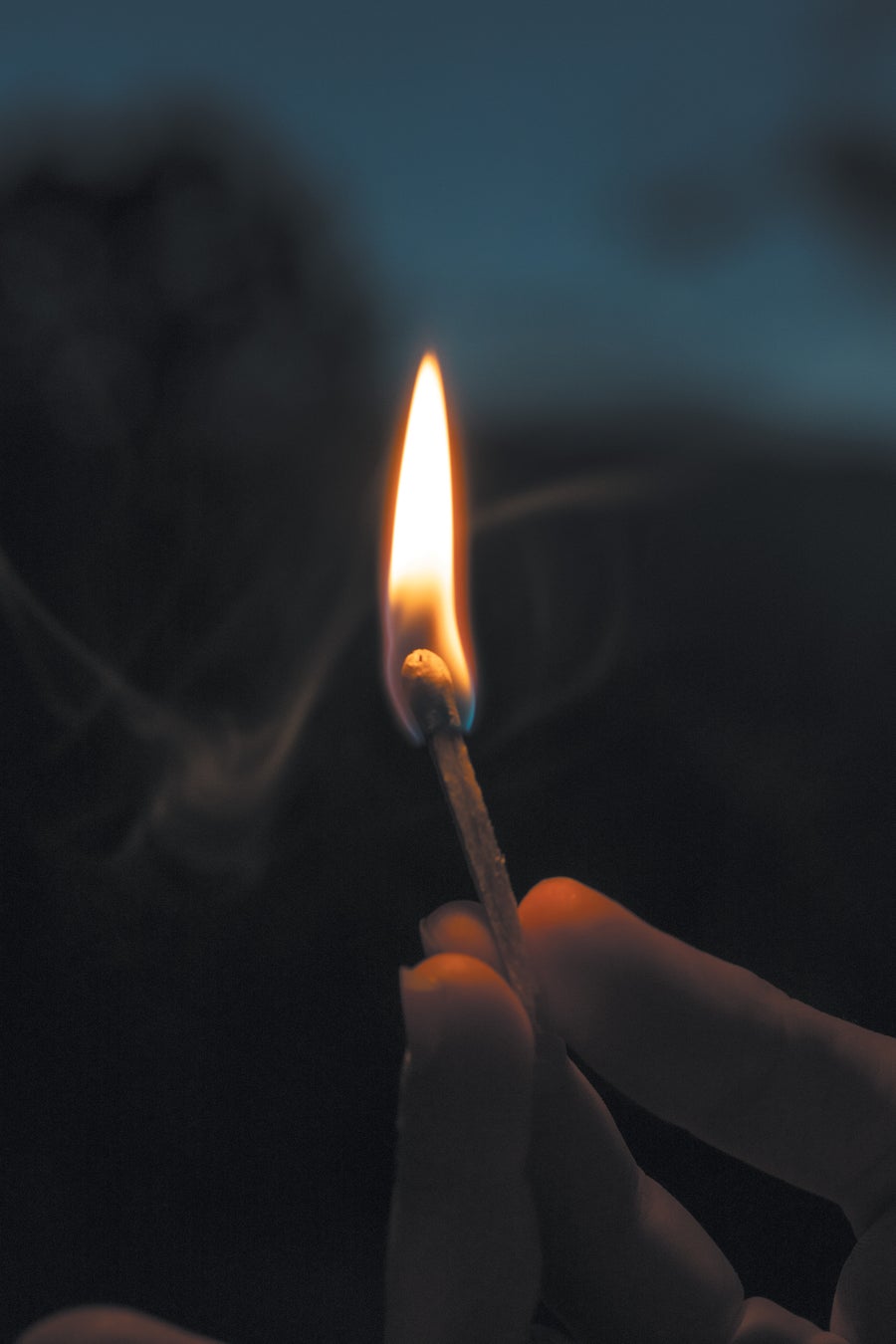
Kevin Cooley 凯文-库利
The competition between first and second fire expanded to include third fire. I call this shift the pyric transition because the demographics of fire seem to have emulated those of people as they underwent industrialization. Humanity has used its firepower to remake all its habitats, one after another. That third fire abolishes open fire has been taken by Western elites as a measure of modernity. To them, flame is slovenly, backward, even atavistic, tolerable only when used for ceremonial purposes. Working fires are those that are housed in machines.
第一把火和第二把火之间的竞争扩大到了第三把火。我把这种转变称为 "火热过渡",因为火的人口结构似乎与人类经历工业化时的人口结构相似。人类利用火力改造了一个又一个栖息地。西方精英将第三种火废除明火作为衡量现代性的标准。对他们来说,火焰是邋遢的、落后的,甚至是未开化的,只有在用于仪式目的时才可以容忍。工作用火是指安装在机器中的火。
So fire has disappeared in many domestic settings, sublimated into electricity. It has disappeared in urban environments. Historically, cities burned as often as their surrounding countryside; after all, they were made of the same materials and responded equally to drought and wind. Perhaps the best-known example is the swarm of fires that, on October 8, 1871, burned both the city of Chicago and the town of Peshtigo, Wis., amid a million acres of charred forest around Lake Michigan. But modern cities are designed not to burn, made of materials that have already passed through flames to become cement, glass and metal and then been arranged in ways that retard fire’s spread.
因此,在许多家庭环境中,火已经消失,升华为电。在城市环境中,火也消失了。历史上,城市与周围的乡村一样经常发生火灾;毕竟,它们是由同样的材料制成的,对干旱和大风的反应也是一样的。最著名的例子也许是 1871 年 10 月 8 日的那场大火,芝加哥市和威斯康星州的佩什蒂戈镇都被烧毁,密歇根湖周围的一百万英亩森林被烧焦。但是,现代城市的设计并不适合燃烧,它们是由已经经过火焰烧成水泥、玻璃和金属的材料制成的,然后以延缓火势蔓延的方式排列。
A similar process has occurred in agriculture. The green revolution is about not just clever breeding but the “inputs” that amplify plant growth. Whereas open fire converted dead biomass into nutrients and purged sites of pests and competing plants, modern agriculture relies on petrochemicals that get cooked into fertilizer and biocides and delivered by pumps, planes and tractors powered by fossil fuels. Fallow—potentially arable land left “idle” during the growing season—fell out of favor. European agronomists and officials had always hated fallow, which they regarded as a waste of good land, and burning of these fields added insult. Yet fallowing contributed to agriculture’s biodiversity.
农业也经历了类似的过程。绿色革命不仅涉及巧妙的育种,还涉及促进植物生长的 "投入"。明火将枯死的生物质转化为养分,并清除害虫和竞争植物,而现代农业则依赖石化产品,这些产品被蒸煮成肥料和杀菌剂,并由化石燃料驱动的水泵、飞机和拖拉机输送。休耕--在生长季节 "闲置 "的潜在可耕地--不再受欢迎。欧洲的农学家和官员一直痛恨休耕,认为这是对良田的浪费,而焚烧这些田地更是雪上加霜。然而,休耕为农业的生物多样性做出了贡献。
Most spectacularly, the pyric transition extended into remote lands—forest reserves, nature preserves, the distant bush, the outback. Officials applied the new counterforce made possible by third fire and sought to abolish flame in wildlands as they had in other habitats.
最引人注目的是,火的过渡扩展到了偏远地区--森林保护区、自然保护区、遥远的丛林和内陆地区。官员们运用第三把火带来的新的反作用力,试图像在其他栖息地一样,在荒野中消灭火焰。
There are good reasons to eliminate flames (and their inevitable smoke) in houses and cities. Few residents would want them back except as an occasional amenity. But pushing that change into the countryside and backcountry is different. The provocation was a wave of megafires during the late 1800s and early 1900s that were larger and more lethal than those of previous decades. Locomotives opened land to logging and clearing, which covered landscapes with combustible slash, over which trains scattered sparks from their smokestacks and brakes with abandon. The wreckage unleashed by fire and axe inspired state-sponsored conservation—a global project to protect landscapes, especially forests, from destruction. Between 1891 and 1905 the U.S. began reserving forests, granted them a charter and established an institution, the U.S. Forest Service, to administer it all.
在住宅和城市中消除火焰(及其不可避免的烟雾)是有充分理由的。除了作为偶尔的娱乐设施,很少有居民希望恢复火焰。但是,将这种变化推向乡村和荒野就不同了。19世纪末和20世纪初的特大火灾浪潮是一个诱因,这些火灾比之前几十年的火灾规模更大、更致命。机车为伐木和开荒开辟了土地,可燃的荒草覆盖了大地,火车在荒草上肆无忌惮地散落着烟囱和刹车的火花。大火和斧头造成的破坏激发了由国家发起的保护活动--一项旨在保护景观(尤其是森林)免遭破坏的全球性项目。1891 年至 1905 年间,美国开始保护森林,授予森林特许状,并成立了一个机构--美国林务局来管理这一切。
The consensus wisdom was that such fires were intolerable. Bernhard Fernow, an émigré forester from Prussia who headed the Division of Forestry (predecessor to the Forest Service), dismissed the spectacle as one of “bad habits and loose morals,” unworthy of an aspiring great power. Gifford Pinchot, first chief of the Forest Service, likened the challenge of fire protection to the abolition of slavery. Their views were typical of forestry that had emerged from central Europe, which saw fire as a metric of social behavior. They regarded fires as they might malaria or banditry: the world would be better off without them.
人们一致认为,这种火灾是不可容忍的。伯恩哈德-费尔诺(Bernhard Fernow)是一位来自普鲁士的移民林务官,曾担任林业司(林务局的前身)的负责人,他将这种景象斥之为 "陋习和不道德",不配作为一个有抱负的大国。林业局首任局长吉福德-平肖特(Gifford Pinchot)将防火挑战比作废除奴隶制。他们的观点是典型的从中欧兴起的林业观点,即把火灾视为社会行为的衡量标准。他们看待火灾就像看待疟疾或强盗一样:没有火灾,世界会变得更好。
As emissaries of modernity, foresters dismissed traditional fire knowledge and practice. Fire control became foundational to conservation, a global project that ranged from the Rocky Mountains of North America to the Central Provinces of India. Foresters in the U.S. made “systematic fire control” their special contribution to world forestry.
作为现代化的使者,林务人员摒弃了传统的防火知识和做法。火灾控制成为保护的基础,这是一项全球性工程,范围从北美的落基山脉到印度的中部省份。美国的林务人员将 "系统防火 "作为他们对世界林业的特殊贡献。
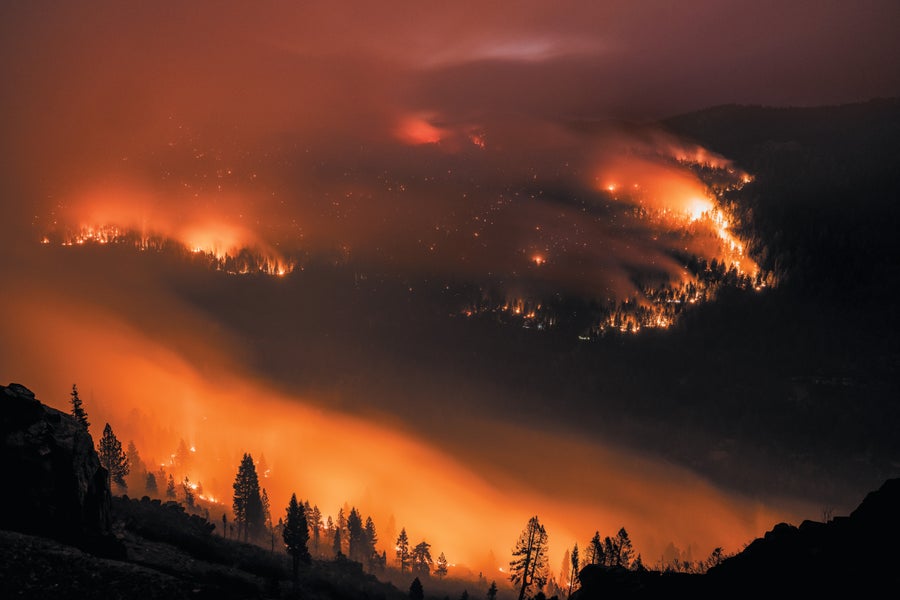
Kevin Cooley 凯文-库利
They went at it with extraordinary verve and resolve. Burned area decreased sharply, especially after World War II, aided by immense stocks of war-surplus hardware converted for firefighting. Industrial-scale fire protection thus became another marker in the Great Acceleration in global change. In the U.S., the burning of living landscapes plunged as the burning of lithic landscapes bolted upward. The period between the mid-1940s and the mid-1980s was a sweet spot in which technology and active suppression shrank free-burning fires to a pittance. Third fire overwhelmed first and second fire.
他们以非凡的勇气和决心投入其中。特别是在第二次世界大战之后,由于大量战争剩余物资被转用于消防,被烧毁的面积急剧下降。因此,工业规模的消防成为全球变化大加速的另一个标志。在美国,生物景观的焚烧量急剧下降,而石质景观的焚烧量却直线上升。20 世纪 40 年代中期到 80 年代中期是一个甜蜜的时期,在这一时期,技术和积极的灭火措施将自由燃烧的火灾减少到微不足道的程度。第三次火灾压倒了第一次和第二次火灾。
By the 1960s the ecological blowback was apparent. Wildlands are not cities; fuels build up, threatening to stoke uncontrollable conflagrations. Ecosystems rot, choked by the absence of fire’s renewing spark. Between 1968 and 1978, federal agencies reformed their policy from suppression-only to a mixed program centered on restoring good fire.
到了 20 世纪 60 年代,生态反弹已显而易见。荒野不是城市;燃料堆积,有可能引发无法控制的大火。生态系统因缺乏火的再生火花而窒息腐烂。1968 年至 1978 年间,联邦机构改革了政策,从单纯的扑火转变为以恢复良好火势为中心的混合计划。
Note that all this happened before any wide concern about climate change. Since then, global warming, like a performance enhancer, has added energy to fire’s expression, and it has globalized the consequences. Even places that have not attempted the pyric transition feel its effects.
请注意,这一切都发生在人们广泛关注气候变化之前。从那时起,全球变暖就像一种性能增强剂,为火的表现形式增加了能量,并使后果全球化。即使是没有尝试过火的地方也感受到了它的影响。
Like the pyric transition, the shift in fire-management approach happened quickly. After the Great Fires of 1910—which burned three and a quarter million acres in northern Idaho and western Montana, part of five million across the West—the U.S. spent 50 years trying to take all fire out of its landscapes and then another 50 trying to put good fire back in. The aftershocks promise to continue for a long while.
与火灾过渡一样,火灾管理方法的转变也发生得很快。1910 年的大火在爱达荷州北部和蒙大拿州西部烧毁了 355 万英亩的土地,而整个西部则烧毁了 500 万英亩的土地,在大火之后,美国花了 50 年的时间试图将所有的火从其土地上清除出去,然后又花了 50 年的时间试图将好火重新放回土地上。余震还将持续很长一段时间。
Let’s widen our aperture and consider fire’s big history. As long as Earth has had terrestrial vegetation, it has had first fire. Second fire appeared in the Pleistocene epoch, competing with first fire. During the Holocene epoch, which began approximately 11,700 years ago, people used fire to recode the patches and pulses of fire across the planet. Third fire arrived over the past two centuries. Its geography is different because it includes an axis of deep time. We are taking stuff out of the geological past, burning it in the present and loosing its effluent into the future. Initially third fire competed with first and second fire; more recently, as a result of humans’ overloading the atmosphere with greenhouse gases and promoting changes in land use, third fire has amplified any kind of fire on the land.
让我们扩大视野,看看火的悠久历史。只要地球上有陆地植被,就会有第一把火。第二代火出现在更新世,与第一代火竞争。在大约 11700 年前开始的全新世时期,人们用火重新编码了地球上的火斑和火脉。第三代火是在过去两个世纪中出现的。它的地理环境与众不同,因为它包含了深层时间轴。我们从地质历史中提取物质,在当下燃烧,并将其流出物排放到未来。起初,第三把火与第一把火和第二把火竞争;最近,由于人类向大气层排放过量温室气体并推动土地利用方式的改变,第三把火放大了土地上的任何一种火。
Earth is dividing into two realms of combustion. One burns living landscapes; the other burns lithic landscapes. Satellite views of Earth at night show the two realms clearly: countrysides aflame, cities aglow. Consider the two Koreas, a cameo of Earth’s pyrogeography. South Korea has made the pyric transition and is ablaze with electric lights at night, whereas North Korea is dark but shows abundant landscape fires during the day. South Korea is also now experiencing the wildfires typical of industrial nations, which it is fighting with third-fire-powered machines.
地球正在分为两个燃烧领域。一个燃烧的是生物景观,另一个燃烧的是岩石景观。卫星拍摄的地球夜景清楚地显示了这两个领域:乡村在燃烧,城市在燃烧。看看两个韩国,它们是地球火烧地貌的一个缩影。南朝鲜已经完成了火化过渡,夜间电灯通明,而北朝鲜虽然漆黑一片,但白天却有大量的火光景观。南朝鲜现在还经历着工业国家特有的野火,它正在用第三种火力驱动的机器来扑灭野火。
Plenty of disasters can occur when the two realms of combustion meet; think of power lines that start blazes. My favorite contrast is Biosphere 2, a glassed-in, self-contained habitat in Arizona that could be plunked down on Mars. The geodesic structure has a zero-tolerance policy for fire, yet it sits at the base of the Santa Catalina Mountains, which experience fires that are both essential and inevitable (85 percent of the mountains burned in 2003 and 2004). What may be most striking in this scene, and many others like it, is the absence of any middle—a middle ground or a middle narrative that shows humans exercising their historic role as a fire agent and mediating between these two otherwise exclusionary visions.
当燃烧的两个领域相遇时,会发生很多灾难;想想引发大火的电线吧。我最喜欢的对比是 "生物圈 2 号"(Biosphere 2),它是亚利桑那州的一个玻璃封闭、自成一体的栖息地,可以放置在火星上。这个多面体建筑对火灾采取零容忍政策,但它却坐落在圣卡塔利娜山脉的山脚下,那里的火灾是不可避免的(2003 年和 2004 年,85% 的山脉被烧毁)。在这个场景以及其他许多类似的场景中,最令人震惊的可能是没有任何中间地带--中间地带或中间叙事,显示出人类行使其作为火灾媒介的历史角色,并在这两种原本相互排斥的观点之间进行调解。
Widen the aperture further. The Pleistocene’s serial ice ages remade entire landscapes, created continental shifts in biogeography, dramatically changed sea level and spawned serial extinctions. Boosted by the pyric transition, fire is assuming the position previously held by ice. Climate change fomented by third fire is driving off ice and remaking landscapes; it’s causing continental shifts in biogeography, changes in sea level and a wave of extinctions. Instead of outwash plains, we have heat domes, and instead of permafrost, permathaw. The ice of the Pleistocene has yielded to the fires of a Pyrocene.
进一步扩大光圈。更新世的连续冰期重塑了整个地貌,造成了生物地理学上的大陆性变化,极大地改变了海平面,并引发了连续的物种灭绝。在火热过渡的推动下,火正在取代冰的地位。第三次火灾引发的气候变化正在驱走冰雪,重塑地貌;它正在造成生物地理学上的大陆性转变、海平面的变化和一轮灭绝浪潮。热穹代替了冲积平原,永久冻土代替了永久冻土。更新世的冰层已屈服于火新世的火焰。
And the humans? Consider the inhabitants of Fort McMurray in Alberta, Canada. They live in a modern city established to mine tar sands but sited in a boreal forest. In 2016 a fire, most likely ramped up by global warming, bolted out of the bush, burned through the town, shut down Suncor’s mining operations and then continued untrammeled by any efforts to contain it. The residents fled in their petrol-powered vehicles. Fort McMurray—a creation of our fire age. Fort McMurray—a place that burned both ends of its combustion candle. Fort McMurray— a portal to the Pyrocene.
人类呢?想想加拿大阿尔伯塔省麦克默里堡的居民。他们生活在一座为开采焦油砂而建立的现代化城市中,但这座城市却坐落在北方森林中。2016 年,一场很可能因全球变暖而加剧的大火从灌木丛中蹿出,烧毁了整个城镇,关闭了 Suncor 公司的采矿业务,然后继续蔓延,没有受到任何控制。居民们开着汽油车逃之夭夭。麦克默里堡--火灾时代的产物。麦克默里堡--一个燃烧蜡烛两端的地方。麦克默里堡--通往 "二茂纪 "的门户。
Today we live in a fire age in which ancient prophecies of worlds destroyed and renewed by fire have become contemporary realities, even for people living in modern cities. In the summer of 2023 millions of residents of New York City and other metropolises saw dark-orange daytime skies thick with smoke palls from Canadian wildfires—and breathed in the effluent. Mythology has morphed into ecology. We’re witnessing a slow-motion Ragnarok—a story from Norse mythology in which a great battle burns the world. Climate history is becoming a subnarrative of fire history.
今天,我们生活在一个火的时代,古代关于世界被火毁灭又被火更新的预言已成为当代现实,甚至对生活在现代城市中的人们来说也是如此。2023 年夏天,纽约市和其他大都市的数百万居民看到橘红色的白天,天空中弥漫着来自加拿大野火的浓烟,他们呼吸着这些废水。神话已经演变成生态学。我们正在目睹一场慢动作的 "世界末日"(Ragnarok)--一个北欧神话中的故事,一场大战烧毁了整个世界。气候史正在成为火灾史的子叙事。
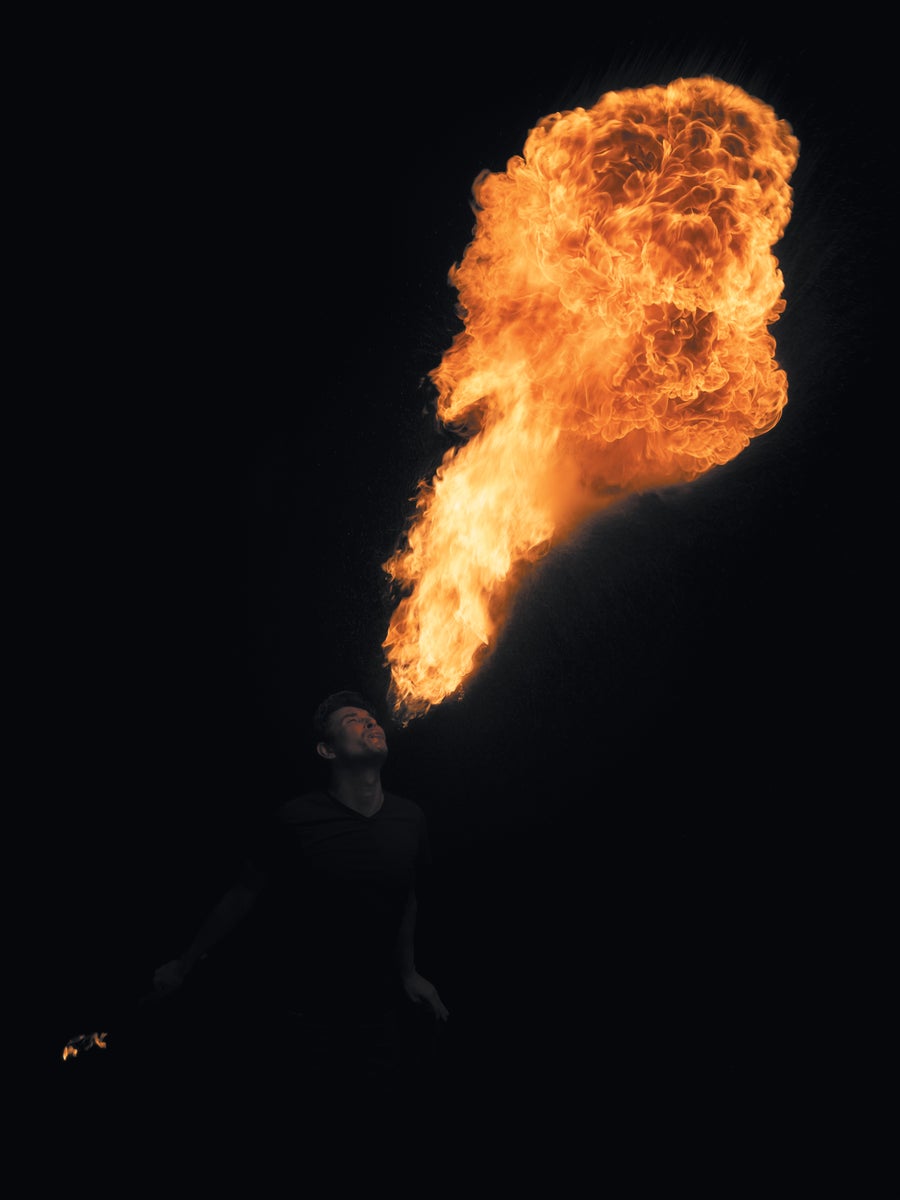
Kevin Cooley 凯文-库利
In the 21st century experts in lots of disciplines have proposed ways to cope with fire challenges. Let me close by proposing three responses—a fire triangle for the Pyrocene.
在 21 世纪,许多学科的专家都提出了应对火灾挑战的方法。最后,请允许我提出三项应对措施--火化工的防火三角。
The first side of the triangle: We have too much bad fire. We have too many fires that kill people, destroy communities and trash valued landscapes. In trying to abolish fire, we killed off many of the good fires that make bad ones easier to fight.
三角形的第一边:我们有太多糟糕的火灾。我们有太多的火灾夺去了人们的生命,摧毁了社区,破坏了宝贵的景观。在试图消灭火灾的过程中,我们扼杀了许多好火,而好火会让坏火更容易扑灭。
But modernity has shaped communities that are particularly vulnerable to fire. The problem of urban fire was solved a century ago. Watching towns burn today is like watching the return of polio or smallpox. Partly, the issue is a matter of definition. We defined the wildland-urban fire from the wildland side, viewing it as wildland fire complicated by houses. We should have defined the problem as urban fire complicated by peculiar landscaping. Define the problem as wildland fire, and it’s nearly unsolvable. Define it as urban, and we know exactly what protective measures need to be taken.
但是,现代性造就了特别易受火灾影响的社区。城市火灾问题早在一个世纪前就已解决。今天,看着城镇被烧毁,就像看着脊髓灰质炎或天花卷土重来。部分原因在于定义问题。我们从野外方面来定义野外-城市火灾,将其视为因房屋而复杂化的野外火灾。我们应该把问题定义为因特殊景观而复杂化的城市火灾。把问题定义为野地火灾,几乎是无法解决的。如果把它定义为城市火灾,我们就能清楚地知道需要采取哪些保护措施。
The second side: We have too little good fire. Restoring fire is tricky. As is true of reintroducing any lost species, it’s much easier to take fire out than to put it back in. We need to recover a lot of traditional knowledge while adapting it for current conditions. We can send people with drip torches along old trails, burn cropland set-asides as fallow, and create hybrid management schemes that alloy suppression and prescribed burning of single fires, especially those in nature preserves and in the backcountry.
第二方面:我们的好火太少了。恢复火是一件棘手的事。就像重新引入任何失落的物种一样,把火 "拿掉 "比把它 "放回去 "容易得多。我们需要恢复大量传统知识,同时使其适应当前条件。我们可以派人拿着滴水火把沿着古老的小径前进,将耕地作为休耕地烧掉,并制定混合管理计划,对单次火灾(尤其是自然保护区和荒野中的火灾)进行压制和规定燃烧。
Note, however, that replacing fossil fuels with renewables as a primary energy source will not be enough. If we use renewables to sustain the same landscapes we have now, we will have the same fire problems, though perhaps tamped down by lessened global warming. The U.S. still has a major fire deficit. As we ratchet down our burning of lithic landscapes, we’ll have to ratchet up our burning of living landscapes. We have a lot of fire in our future.
但要注意的是,仅以可再生能源取代化石燃料作为主要能源是不够的。如果我们使用可再生能源来维持与现在相同的地貌,我们将面临同样的火灾问题,尽管全球变暖的程度可能会减轻。美国仍然存在严重的火灾隐患。当我们减少对石质景观的焚烧时,我们必须增加对生物景观的焚烧。我们的未来需要大量的火。
The third side: We have way too much combustion overall. We must shut down the burning of fossil fuels. We can mitigate its effects only so much.
第三方面:我们的燃烧总量太大了。我们必须停止燃烧化石燃料。我们只能尽量减轻其影响。
Here let me leave the U.S. for Victoria, Australia, and the saga of the Hazelwood power station. Hazelwood was erected to burn brown coal from an adjacent open-pit mine. In 2009 power lines in the area kindled fires in the Black Saturday bushfire outbreak. A few years later bushfires ignited the open-pit mine. The two realms of fire were turning on each other. It’s common for open-pit mines to consume the communities around them; in this case, the bush consumed the mine. What parable will we extract from this saga?
下面,让我离开美国,来到澳大利亚维多利亚州,讲述黑泽尔伍德发电站的传奇故事。黑泽尔伍德电站的建立是为了燃烧邻近露天矿的褐煤。2009 年,该地区的输电线在 "黑色星期六 "丛林大火中点燃了大火。几年后,丛林大火又点燃了露天矿。两场大火互相蔓延。露天矿通常会吞噬周围的社区;在这种情况下,丛林吞噬了矿山。我们能从这个传奇故事中得到什么启示呢?
As we approach our fire-informed future, I’m reminded of the Old Testament prophet Ezekiel, who declaimed, “They shall go out from one fire, and another fire shall devour them.” We hold a species monopoly over fire. It’s what we do that no other creature does; it’s our role in the great chain of being. For us, fire is not just an ecological process or a tool; it’s a relationship. Through greed and a lust for power, we have turned our ancient companion from our best friend into our worst enemy.
在我们即将迎来火的未来时,我想起了《旧约》中的先知以西结,他曾宣称:"他们必从一个火中出来,另一个火必吞灭他们"。我们是火的垄断物种。这是我们所做的其他生物所不做的事情;这是我们在存在的大链条中扮演的角色。对我们来说,火不仅是一种生态过程或工具,还是一种关系。由于贪婪和对权力的欲望,我们已经把这个古老的伙伴从我们最好的朋友变成了我们最大的敌人。
Good fire made us. Bad fire may break us. The choice is ours.
好火造就了我们。坏火可能会毁掉我们。选择权在我们手中。
